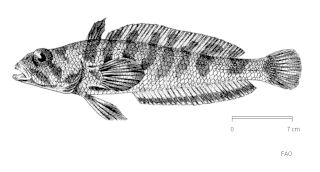
Nototheniidae, the notothens or cod icefishes, is a family of ray-finned fishes, part of the suborder Notothenioidei which is traditionally placed within the order Perciformes. They are largely found in the Southern Ocean.

The Antarctic silverfish, or Antarctic herring, is a species of marine ray-finned fish belonging to the family Nototheniidae, the notothens or cod icefishes. It is native to the Southern Ocean and the only truly pelagic fish in the waters near Antarctica. It is a keystone species in the ecosystem of the Southern Ocean.

Latridopsis forsteri, the bastard trumpeter, copper moki, red bastard trumpeter, red, white and silver bastard trumpeter, silver bastard trumpeter, silver trumpeter or white bastard trumpeter, is a species of marine ray finned fish belonging to the family Latridae, the trumpeters. It is native to the eastern Indian Ocean and southwestern Pacific Ocean. This species is commercially important.

The marbled rockcod is a species of notothen native to the Southern Ocean, where it can be found at depths from 5 to 350 m. This is a commercially important species.

Chaetodon hoefleri, the four-banded butterflyfish, is a species of marine ray-finned fish, a butterflyfish from the family Chaetodontidae. It is native to the tropical eastern Atlantic and has been recorded in the Mediterranean.

Bovichtus is a genus of fish in the family Bovichtidae found in the Atlantic, Indian and Pacific Ocean.
The burrito grunt is a species of marine ray-finned fish, a grunt belonging to the family Haemulidae. It is native to the tropical waters of the eastern Pacific Ocean area.
The blackfin slatey, also known as blackfoot sweetlips, blackfin sweetlips or blacktip sweetlips, is a species of marine ray-finned fish, a sweetlips belonging to the family Haemulidae. It is found in the eastern Indian Ocean and the western central Pacific Ocean.

The longfin icedevil, also known as the threadfin pinhead, is a species of marine ray-finned fish belonging to the family Nototheniidae, the notothens or cod icefishes. It is native to the Southern Ocean where it can be found at depths down to 850 metres (2,790 ft). This species grows to a length of 42 centimetres (17 in) TL. This species is the only known member of its genus and is of no interest to commercial fisheries.

Gobionotothen is a genus of marine ray-finned fishes belonging to the family Nototheniidae, the notothens or cod icefishes. They are native to the Southern Ocean.

Gvozdarus is a genus of marine ray-finned fishes belonging to the family Nototheniidae, the notothens or cod icefishes. It is native to the Southern Ocean.

The grey rockcod, also known as the grey notothen, stripe-eyes notothen or stripe-eyed rockcod, is a species of marine ray-finned fish belonging to the family Nototheniidae, the notothens or cod icefishes. It is native to the Southern Ocean,The grey rockcod feed mainly on macrozooplankton and is of minor importance to commercial fisheries. It is the only species in the genus Lepidonotothen
Pristipomoides typus, also known as the sharptooth jobfish, white snapper, white jobfish, goldband snapper or threadfin snapper, is a species of ray-finned fish, a snapper belonging to the family Lutjanidae. It is found in the Indian and Pacific Oceans.
Pristipomoides flavipinnis, the golden eye jobfish or golden eye snapper, is a species of ray-finned fish, a snapper belonging to the family Lutjanidae. It is found in the Pacific Ocean.

The spotbanded scat,(Selenotoca multifasciatus), also known as the striped scat, banded scat, barred scat, butterfish, John Dory, Johnny Dory, old maid, Southern butter-fish or striped butterfish, is a species of ray-finned fish, belonging to the family Scatophagidae, the scats. They are found in the eastern Indian Ocean and southwestern Pacific Ocean.

Gvozdarus svetovidovi, the naked-head toothfish, is a species of marine ray-finned fish belonging to the family Nototheniidae, the notothens or cod icefishes. It is found in the Ross and Cooperation Seas, probably south of the Antarctic Polar Front from pelagic waters down to depths of 550 m, though it is normally found in a pelagic environment.

Gobionotothen gibberifrons, the humped rockcod or the humphead notothen, is a species of marine ray-finned fish belonging to the family Nototheniidae, the notothens or cod icefishes. It is native to the islands of the Scotia Arc, the northern part of the Antarctic Peninsula, and Heard Island in the Southern Ocean. This species inhabits depths of 6-429 m, but is most abundant at depths of 100-400 m, at least around Elephant Island.

Gobionotothen marionensis, the lobe-lip notothen, is a species of marine ray-finned fish belonging to the family Nototheniidae, the notothens or cod icefishes. It is native to the South Georgia and the South Sandwich Islands in the Atlantic Ocean, and the Crozet and Prince Edward Islands in the Indian Ocean.>

Apsilus dentatus, the black snapper, is a species of marine ray-finned fish, a snapper belonging to the family Lutjanidae. It is found in the western Atlantic Ocean.

Bovictus diacanthus, the Tristan klipfish, is a species of marine ray-finned fish, a temperate icefish or thornfish, belonging to the family Bovichtidae. It is endemic to two isolated, small island groups in the South Atlantic.












